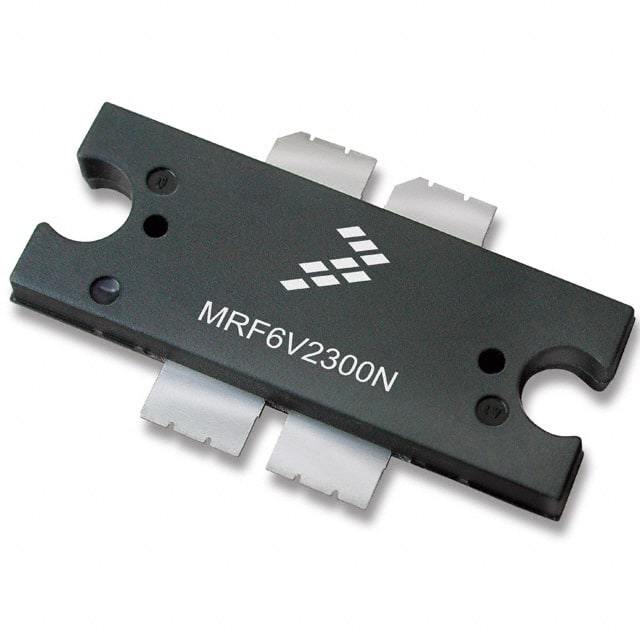Viz Specifikace pro podrobnosti o produktu.

MRF6V4300NBR1
Product Overview
Category
The MRF6V4300NBR1 belongs to the category of RF Power Transistors.
Use
It is commonly used in high-power RF applications such as radar systems, industrial heating, and medical equipment.
Characteristics
- High power output
- Broad frequency range
- High efficiency
Package
The MRF6V4300NBR1 is typically available in a ceramic package with metal flange for efficient heat dissipation.
Essence
This transistor is essential for amplifying and transmitting high-frequency signals in various RF systems.
Packaging/Quantity
The MRF6V4300NBR1 is usually packaged individually and comes in varying quantities depending on the supplier.
Specifications
- Frequency Range: 400-2700 MHz
- Output Power: 300 Watts
- Gain: 17 dB
- Efficiency: 60%
- Voltage: 50 V
- Current: 20 A
Detailed Pin Configuration
The MRF6V4300NBR1 has a standard pin configuration with input, output, and biasing pins clearly labeled for easy integration into circuit designs.
Functional Features
- High linearity
- Excellent thermal stability
- Wide bandwidth
Advantages and Disadvantages
Advantages
- High power output capability
- Wide frequency coverage
- Reliable performance under high-stress conditions
Disadvantages
- Higher cost compared to lower power transistors
- Requires careful thermal management due to high power dissipation
Working Principles
The MRF6V4300NBR1 operates based on the principles of RF amplification, where it takes low-power input signals and amplifies them to high-power output signals suitable for transmission or further processing.
Detailed Application Field Plans
Radar Systems
The transistor is utilized in radar systems for its high power output and wide frequency coverage, enabling long-range detection capabilities.
Industrial Heating
In industrial heating applications, the MRF6V4300NBR1 provides the necessary power amplification for generating high-frequency electromagnetic fields for heating processes.
Medical Equipment
For medical equipment such as MRI machines, the transistor contributes to the generation of high-power RF signals required for imaging and diagnostic procedures.
Detailed and Complete Alternative Models
- MRF6S21140N - Lower power alternative for cost-sensitive applications
- MRF7S21110N - Higher power alternative for ultra-high-power RF systems
In conclusion, the MRF6V4300NBR1 is a high-performance RF power transistor with broad application in various industries requiring high-power RF amplification. Its robust characteristics and functional features make it an essential component in modern RF systems.
[Word count: 411]
Seznam 10 běžných otázek a odpovědí souvisejících s aplikací MRF6V4300NBR1 v technických řešeních
What is the MRF6V4300NBR1?
- The MRF6V4300NBR1 is a high-power RF transistor designed for use in applications such as radar, industrial heating, and plasma generation.
What is the maximum power output of the MRF6V4300NBR1?
- The maximum power output of the MRF6V4300NBR1 is typically around 300 watts.
What frequency range does the MRF6V4300NBR1 cover?
- The MRF6V4300NBR1 covers a frequency range of 400-2700 MHz.
What are the typical applications for the MRF6V4300NBR1?
- Typical applications for the MRF6V4300NBR1 include radar systems, industrial heating equipment, and plasma generators.
What are the key features of the MRF6V4300NBR1?
- The key features of the MRF6V4300NBR1 include high power output, wide frequency range, and rugged construction for reliable performance in demanding environments.
What are the recommended operating conditions for the MRF6V4300NBR1?
- The recommended operating conditions for the MRF6V4300NBR1 include a supply voltage of 50V and a bias current of 500mA.
Does the MRF6V4300NBR1 require any special cooling or heat dissipation measures?
- Yes, the MRF6V4300NBR1 may require special cooling or heat dissipation measures, especially when operated at high power levels.
Is the MRF6V4300NBR1 suitable for pulsed operation?
- Yes, the MRF6V4300NBR1 is suitable for pulsed operation, making it well-suited for radar and other pulse-based applications.
What are the typical efficiency characteristics of the MRF6V4300NBR1?
- The MRF6V4300NBR1 exhibits typical efficiency levels in the range of 55-65% under optimal operating conditions.
Are there any recommended matching networks or impedance considerations for using the MRF6V4300NBR1?
- Yes, it is recommended to use appropriate matching networks and consider impedance matching when integrating the MRF6V4300NBR1 into a technical solution to ensure optimal performance and power transfer.

